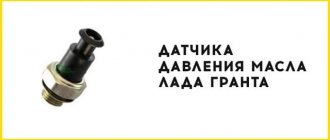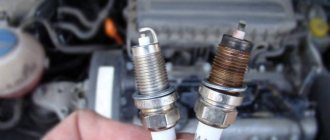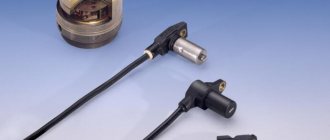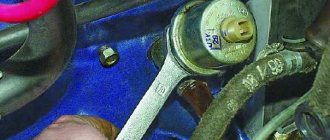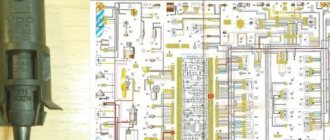Where is the oil pressure sensor located? It is located just below the block head cover, see the photos below for more details:
Note! A protective cover is installed on top of the oil pressure sensor, which, unfortunately, is removed in the photo, so when you look for this sensor, look closely at its protective cover, and not at the sensor itself. (What kind of protective cover is installed on the sensor, see the first picture, in the “Removing the sensor” section)
When should you change the oil pressure sensor? It must be replaced when worn out, this can be determined in the following ways:
1. The first signs of a sensor malfunction are the oil pressure lamp indicator lighting up on the instrument cluster.
Note! But here you need to be absolutely sure that everything is in order with the engine, otherwise, as happens, people first blame the sensor, and later they find out that they actually have a problem with the engine, so so that such questions do not arise, check carefully :
• The oil level in the engine, if the level is too low, then bring it to normal. (How to check the level and bring it to normal, see the article: “Changing the oil”)
• Further, the electrical wiring that is connected to the sensor may also be faulty.
• Also, the oil pressure lamp coming on can be caused by some kind of malfunction in the engine lubrication system.
2. If the oil pressure sensor is faulty, it may also be oily, so first of all, take a closer look to see if there are any oil particles on your sensor.
How to replace the oil pressure sensor on a VAZ 2108-VAZ 21099?
Removal: 1) First, by hand, disconnect the wire, together with the protective cover, from the sensor.
2) Next, using a wrench, completely unscrew the sensor.
3) And then remove it from the hole.
Installation: 1) Install the new sensor into the hole first.
2) And after installation, screw it all the way using a wrench.
3) After the sensor is screwed in, connect the wire to it by hand, together with the protective cover.
Important! When choosing a new sensor in a store, pay special attention to its markings; we recommend that you install a new sensor with the same markings that were applied to the old sensor!
Every modern car, including the VAZ 2109, is equipped with a variety of sensors and devices, each of which plays its own important role. One such device is the oil pressure sensor. It is located in the engine compartment. Regardless of which engine the car is equipped with, an injector or a carburetor, the sensor is located on top of the cylinder block on the intake manifold side.
A protective cover is installed on top of the oil pressure sensor. To ensure stable operation of the engine and the entire machine as a whole, it is necessary to ensure that the sensor is working properly. An oil filter is located next to the sensor.
Where is the sensor located
The most common places where it is found are near the oil filter, in the upper part of the engine near the camshaft block, or pump.
Let's look at specific models:
The most common wrench size for removing the sensor is 21. You can use a spark plug wrench. But it all depends on the specific brand of car.
After the pressure sensor has been removed, the seat is tightly covered with a clean rag so that dirt does not get there and oil does not leak out during possible engine operation.
It would be a good idea to measure the oil pressure in the system at idle, medium and high speeds. To do this, use a pressure gauge, which is screwed in instead of the DDM. To take accurate readings, it is important to ensure a tight connection.
For each car model, the values may differ. These can be found in the instruction manual.
For example, for a VAZ 2112 there are 16 valves, the standard engine oil pressure is:
If all the readings are normal and the light is constantly on, then the information does not reach the ECU or gets distorted. This may be due to the sensor, which needs to be checked.
Sensor design
The oil pressure sensor in modern cars is quite simple. It includes an outer casing, a hard elastic membrane and a transfer device. The principle of interaction of the device is the interaction of oil with an elastic partition.
The membrane reacts to the force with which the oil presses on it. The oscillations of the partition, the opening and closing of the contacts of the electrical circuit, communicate with the rheostat. Changes in rheostat indicators are displayed on the dashboard of the VAZ-2109.
A malfunction of the sensor is indicated by a light on the panel. When an alarm icon appears, you must immediately check the serviceability of the sensor. But before doing this, you should make sure that the engine oil level is correct.
Today there are several oil pressure sensors for the VAZ-2109, which any owner of this car can purchase if necessary. The table shows the types of sensors, as well as their article numbers and prices.
| Sensor | vendor code | Cost, in rubles |
| Oil pressure sensor analog MM120D | SOP20101O7 | 80 |
| Oil pressure sensor VAZ Samara | 33000 | 150 |
| Oil pressure sensor (BCG) | OS3518-BCG | 150 |
| Oil pressure sensor ERA | 11260 | 100 |
Types of DDM
Oil pressure sensors are divided into two types:
Mechanical sensors
Mechanical sensors by design are divided into:
The first ones consist of a body, a membrane, two rods, and a sealed tube.
As the pressure in the lubrication system increases, the membrane bends, putting pressure on the first rod, thereby increasing the pressure in the tube. The second rod takes this pressure and transmits it to the differential pressure gauge (located on the instrument panel).
The pressure increases - the arrow of the device deviates in a larger direction, falls - the arrow goes down to the left. The principle of operation is the same as that of a pressure gauge.
The mechanical oil pressure sensor with rheostat consists of:
The device operates on the principle of a voltmeter. The rheostat and slider play a key role here.
The rheostat changes its resistance depending on where the slider is moved. The latter, in turn, shifts in one direction or another as the membrane bends or straightens.
When there is no pressure, the membrane is not deformed and the slider does not move, the current passes freely without encountering any resistance along its path.
As the pressure increases and the membrane deforms, the slider moves along the rheostat, thereby increasing the resistance in the circuit; accordingly, the current readings change, which is displayed on the device in the driver’s cabin.
All this is recorded by the ECU, to which the sensor is connected. It is programmed in such a way that only one period of current values is equal to the standard oil pressure. Exceeding this interval is equivalent to an incorrect value.
This is clearly visible on dial analog pressure gauges, which, in fact, are ordinary voltmeters.
Electronic sensors
Electronic DDM is much simpler than its mechanical counterpart, so it is considered more reliable.
Essentially, this is an emergency sensor that does not show the pressure in the system, but only notifies the driver when it is within normal limits and when it is not.
Sensor check
In practice, there are several proven methods for checking the oil pressure sensor.
The first method involves removing the device and idling the starter. If, when the device for mechanical engine starting is turned on, oil begins to pour out from the location of the sensor, then the device is in working order.
You need to carefully inspect the sensor, then treat it with a degreasing liquid, for example, gasoline. Then the sensor must be returned to its original place. If in this case the light on the dashboard remains on, it means that the sensor has failed and needs to be replaced.
The second verification method is more thorough. In this case, you should do the following:
- Check oil level.
- Start the engine and warm up the car.
- Unscrew the sensor and connect it to the device for testing. An adapter from a pressure gauge should be installed in place of the sensor.
- Ensure that the pressure gauge is in contact with the ground (ground).
- Connect the positive LED from the battery to the sensor contact.
- Start the engine, press the gas pedal.
- If the pressure gauge shows a value of 1.2-1.6 bar, the LED will turn off; if not, then the sensor has failed.
Often a light comes on on the dashboard of the VAZ-2109, indicating problems with oil volume
The third method involves checking the oil pressure sensor using the crankshaft. To do this, you need to crank the crankshaft without turning on the engine. At the same time, pour oil into the place where the sensor was screwed in. If the light is on, it means the device is unusable and needs to be replaced.
VAZ-2109 owners check the sensor in different ways:
First.
Remove the DDM located above the oil filter, turn the starter, the engine cannot be started during such a check. If all is well, oil should flow out. Then visually check the condition of the sensor. If there is no damage, then wash it with gasoline. They are installed in place. The light will go off. If it continues to burn, then it needs to be changed. Second. Check the oil level. If it’s low, add lubricant, then check again whether the light is on or not. Next, warm up the engine and then turn it off. Then connect to a pressure gauge. This adapter from the pressure gauge is screwed into place of the sensor and grounded through the ground of the car. Connect the signal LED to the battery positive and the sensor, start the engine and step on the gas. When the pressure gauge reads 1.2-1.6 bar, the LED goes out. If it lights up, then the DDM is broken.
The car owner must always monitor the condition of the DDM. After all, he also has problems. And these problems can affect the technical condition of the machine. You should not allow breakdowns, because if the engine jams, this will lead to large financial expenses.
Replacing the sensor
The process of removing and installing the sensor is quite accessible to any car enthusiast. Before screwing in the new sensor, you need to check the markings.
Experts recommend installing a new sensor with the same markings as the old one.
- First you need to disconnect the wire with the protective cover from the sensor.
- Using a wrench, unscrew the bolt and remove the sensor.
- Install the new sensor in place.
- After this, you should tighten it until it stops with a wrench.
Finally, you should start and stop the engine several times to check its operation and absence of malfunctions.
What to do if the sensor lights up
If the oil pressure light on the dashboard comes on and does not go away for a long time, it can be assumed that there are problems with the engine. Sometimes this may be due to a loose wire.
There are several main reasons why the warning light on your dashboard comes on. These include:
- installation of a low-quality oil filter. Low quality filters are not able to retain oil after the car is stopped. The solution is to replace the oil filter;
- insufficient oil level. In this case, it is necessary to add oil to the required level and find the cause of the leak;
- oil pump damage. It is recommended to have this problem repaired at a service station.
Thus, the oil pressure sensor on the VAZ-2109, despite its small size, plays a rather important role in ensuring the correct and stable operation of the car.
It requires constant monitoring and, if minimal signs of malfunction appear, mandatory replacement. This is the only way to extend the life of the engine of any car and avoid unnecessary financial costs that may arise due to sensor malfunctions.
The owner of the Nine will most likely find out that there is a VAZ 2109 oil pressure sensor and an oil level sensor in the engine compartment when the indicator on the instrument panel lights up red, indicating that there are problems with the oil pressure level. And then many questions immediately arise, including what kind of oil should be poured into the system, whether its volume is sufficient, but most importantly, whether this small device has deteriorated. Let's take a closer look at what an oil pressure controller is, what its operating principle is, and how accurately its performance can be determined.
Return to contents
On a note
Don’t fall into a premature panic, draw too hasty conclusions, drive to a service station and pay money for faults that might not even exist! An emergency pressure lamp indicates a drop in lubricant pressure in the system, insufficient oil level in the engine, but it is not yet a fact that this is the reason. A fairly common malfunction is when the oil pressure sensor itself has failed and, accordingly, simply “lies.” If you don't notice this right away and don't understand the reason, you can really waste a lot of money or cause yourself more serious problems.
Sensor design and operating pressure check
To determine whether a device is functional, you need to understand how it works. It is also useful to know how the controller and the VAZ engine, or rather its lubrication system, interact with each other. The sensor is mounted on the cylinder head on the side on which the carburetor is located. Next to the controller there is a VAZ oil filter.
The design of the oil pressure controller is very simple. It consists of a housing, a built-in control and measuring elastic membrane and a transmission mechanism. The principle of operation of the device in question is also quite simple. Engine oil for VAZ, located in the lubrication system, acts on the membrane during engine operation.
The latter is deformed by an amount corresponding to the oil pressure. Vibrations of the elastic “partition”, which make or break the contacts of the electrical circuit, are transmitted to the rheostat through the mechanism mentioned above. In turn, changing the resistance of the rheostat affects the indicator readings on the car’s dashboard.
Checking the operating oil pressure using the crankshaft is used, as a rule, in cases where the indicator begins to signal a drop in pressure in the lubrication system away from the service station, and the driver does not have a pressure gauge at hand.
Before checking, you must make sure that the oil level in the system and the corresponding VAZ 2109 filter are in order. If the level is insufficient, the oil will have to be filled to the nominal level. Then you can proceed directly to checking the health of the sensor. For this purpose, it is unscrewed from the socket.
With the lubrication system open, the crankshaft of the machine is turned manually (without turning on the engine). If at the same time the hole into which the oil pressure controller was screwed begins to fill, then the pressure is normal. The indicator that continues to light indicates that the sensor has failed.
In this case, the device should be carefully inspected for defects. If there is no damage, it must be washed with gasoline (diesel) and installed in its original place. If the light continues to light after this, the sensor will have to be replaced.
Return to contents
Oil pressure light on VAZ 2109 injector
A fairly common problem is that the brake lights on the VAZ 2109 do not light up. And it is difficult to call it insignificant: they send a signal to drivers driving behind that your car is braking.
Thus, road users are warned, and they themselves, accordingly, reduce their speed. I didn’t warn you, they drove you into the appropriate place - it’s your own fault. Moreover, you will have to pay not only for your car, but also for the restoration of the car that carried out the collision, since it is its owner who will be considered the injured party. And such a development of the situation in a city with heavy traffic is very likely. Heavy traffic does not contribute to maintaining a distance of 5 m, as provided for in the traffic rules. Cars move one after another during rush hours: any carelessness can lead to an accident. Moreover, both warning lights may not work, or only one may fail - and in this case, you can consider yourself lucky, there is still a partial warning of the threat from behind.
The brake lights on the VAZ 2109 do not light up for various reasons, from the most trivial to those requiring a thoughtful and more serious examination. Methods for identifying such a malfunction and ways to eliminate it are described in our article.
The first reason that suggests itself is a low level in the engine crankcase. Because you haven't watched it for a long time. When was the last time you checked the level in the engine?
Every second driver will have a low level of lubricant, top it up and everything goes away. However, I constantly monitor the lubricant, and the level is normal, but the lamp comes on. What to do? Of course, look for the problem.
If the pressure lamp flashes when driving downhill, uphill or on turns, then simply add a little lubricant to the engine. It splashes and in such modes the pump cannot reach it. On a flat surface the level will be within acceptable standards.
I do not consider grease waste and leakage, since this does not apply to our case. As you remember, I explain the reasons for the lamp burning when everything seems to be enough.
Checking the pressure controller using a pressure gauge
The second method is more accurate and involves the use of special devices. Note that this method can also test the bypass valve at the same time. The preheated engine, into which the required volume of oil is poured, is turned off. The sensor removed from the engine is screwed into the pressure gauge. In place of the sensor, screw the adapter of the monitoring pressure gauge.
As a result of these connections, the pressure gauge and sensor should form a single circuit that records the impulse from the lubrication system to the indicator. Next, start the engine, its speed is gradually increased until the pressure gauge shows a value of 1.2-1.6 bar. If the sensor is working properly, the LED goes out. If it continues to light, it means the controller has failed.
If the oil pressure indicator is lit when the sensor is operational, it indicates that the cause of the problem is most likely something else. As practice shows, most often this situation can indicate either wear of the crankshaft bearings or a breakdown of the bypass valve. If we are talking about a technically faulty sensor, it is better to replace it with a new one.
This is quite easy to do, and the controller itself is quite inexpensive. It is advisable that, along with replacing the control device, the oil in the VAZ 2109 engine should also be changed. In this case, the problem of what oil to fill and how much to fill should be decided by each motorist separately, depending on the car model and its operating conditions.
In any case, the condition of the sensor must be monitored. After all, even though it is not as complicated as, for example, a carburetor, it also has problems. And they can affect the technical condition of the car no less painfully than breakdowns of more complex units.
The VAZ 2108 car is equipped as standard with an electronic engine oil pressure sensor (hereinafter referred to as EPM). The controller is designed to monitor the pressure inside the oil circuit.
If the readings deviate from the minimum (maximum) range, an indicator on the dashboard indicates a breakdown. The driver, seeing the warning light, decides whether to stop the car and call a tow truck.
There is no need to ignore the “signals” of the instrument panel, since the technical condition of the car depends on how quickly the driver makes decisions.
Each time the ignition is turned on, the oil pressure indicator on the instrument panel lights up briefly. After 2 - 3 seconds the diode goes out until the engine starts again.
Why does the oil pressure light come on in the VAZ 2114/2115
There are several likely reasons why this car light suddenly comes on. And only based on an accurate determination of the cause can the necessary actions be taken to eliminate the malfunction.
The indicator may light up in two cases:
at engine idle speed;
when the car is moving.
Each of these cases has its own causes of malfunctions.
The indicator in the form of an oil can lights up in situations where there is any problem with the oil pressure
The light came on at idle
The oil pressure light may come on (or blink) at idle, and if you press the gas pedal, the icon will immediately go out. In this case, the most likely causes of malfunctions are the following:
the crankshaft liners are worn out: the oil pressure will drop due to the fact that the gap between the thinned liner and the car’s connecting rod has increased;
the oil receiver mesh is severely clogged: one of the most common reasons why a light bulb suddenly lights up. Various types of sediment are gradually deposited on the surface of the engine sump. At the moment when there are too many deposits, the pump can no longer supply enough oil to operate the engine;
wear or any problems in the oil pump: another probable reason why the indicator may light up on a VAZ 2114/2115. Due to a breakdown of the pump itself or any part of it, oil does not enter the engine in the required quantity;
the sensor is faulty: it is quite possible that the oil level and the engine itself fully meet their basic characteristics, and the problem lies in the sensor;
the wiring is shorted: problems in the car’s electronic system can also cause the engine oil supply system to not operate correctly.
The oil can indicator light came on while driving.
In cases where the oil pressure light suddenly comes on while the car is moving, it is advisable to stop immediately. Probably the following failure or breakdown occurred:
the oil level in the engine unit is below the Min mark;
the oil filter could be clogged - this leads to the fact that the pressure invariably decreases;
it's time to change the oil - in cases where the car owner does not replace the substance in the engine for a long time, it loses its working properties.
Where is the oil pressure sensor located on the VAZ 2108
Where is it located: in the VAZ 2108 the DDM is installed below the cylinder head cover, on the right in the direction of travel. The upper part of the sensor is covered with a protective cover to prevent current flow to ground.
Before maintenance or replacement, it is recommended to “disconnect” the power terminals from the battery to avoid a short circuit in the on-board circuit.
Note to the driver!!! Follow safety rules when performing work yourself. A hot engine can damage the skin of your hands.
Oil pressure sensor for VAZ 2108: diagnostics, replacement, price, articles
The process of self-diagnosis and replacement is not at all difficult. Do not violate the rules, be careful.
Diagnostic stages:
- Open the hood, unclip the block with limit switches on the sensor;
- Unscrew the controller (key set to “22”);
- Wipe the part dry (rags);
- Connect the multimeter terminals to the contacts;
- Turn on the device, move to the “Ohmmeter” position;
- Measure the resistance. Range from 545 to 628 Ohms. Deviation from the norm is a sign of a malfunction.
Based on the data obtained, make a decision to replace the part with a new one. DDM is not a collapsible structure and cannot be repaired.
| Name / catalog article | Price in rubles |
| Lada 2108-2545213-0 (original) | From 300 |
| Vernet OS3543, OS3538, OS3516 | From 270 – 410 |
| Autolog AS2109, AS2102 | From 270 – 410 |
| Facet 70096, 70069 | From 270 – 410 |
| SWAG 20230002 | From 270 – 410 |
| Febi 19018 | From 270 – 410 |
| Topran 109894 | From 270 – 410 |
| Automega 150011610 | From 270 – 410 |
| Ossca 00393 | From 270 – 410 |
| Maxgear 210103 | From 270 – 410 |
| Meyle 1009190030 | From 270 – 410 |
| JP group 1193500100 | From 270 – 410 |
| ERA 330341 | From 270 – 410 |
Causes of premature wear of DDM
- Expiration of service life;
- Damage, consequence of an accident, collision, impact;
- Short circuit in the on-board circuit;
- Manufacturing defect.
Signs of DDM malfunction
- The “oil pressure” indicator constantly signals on the dashboard;
- There is an oil leak and signs of depressurization at the controller installation site;
- The fastening of the terminals on the DDM is loosened;
- The engine oil level does not meet the minimum or maximum range.
Step-by-step guide to replacing DDM yourself
Preparatory stage:
- Key to “22”, head, knob;
- Additional lighting as needed;
- Rags;
- New sensor;
- Engine oil for topping up (optional).
Replacement steps:
- Open the hood of the car. We wait until the engine cools down so as not to burn the skin of the hands;
- Using a flat-tip screwdriver, unclip the block with wires from the sensor;
- Unscrew the DDM (key to “22”);
- We carry out troubleshooting of the seat, wipe it with a rag as necessary;
- We screw in the new controller, put on the block with wires;
- Check the oil level and replenish the missing amount.
We start the engine and check the functionality of the controller.
Where is the oil pump on the VAZ 2109
Its location is behind the crankshaft pulley. As a result of this circumstance, it will not be possible to get to it without removing some parts, in particular, the pulley itself and the oil pan. Below is a photo showing the oil pump in its seat.
When to change the oil pump
If the pump fails, the following things happen:
- The oil pressure drops, as a result of which the corresponding control light on the dashboard lights up.
- Oil consumption increases, and it constantly has to be topped up (however, this does not always happen).
How to replace the oil pump on a VAZ 2109, 2108, 21099
Tools:
Before you begin the replacement, prepare all the necessary tools. This is a set of wrenches, a set of sockets, a universal joint and an extension. If the pump is replaced with a new one, then buy the necessary spare part (its catalog number is “2108-1011010″). Also, drive the car into a hole or overpass, otherwise it will be very difficult for you to get to the pump.
Removal:
1) Remove the crankshaft position sensor. It should be noted that this is only relevant for an injection engine; if the engine is carburetor, skip this point.
2) Drain the engine oil.
3) Next, remove the toothed pulley.
4) Now you can remove the oil pan. Then find the oil receiver and unscrew the bolts that secure it, and then remove it.
5) Take the correct size socket and extension and use them to remove the 6 bolts that secure the oil pump to the engine block. Be extremely careful as there are washers under the bolts and it is very important not to lose them.
6) Ideally, after step 6, the pump should be removed, but in practice this does not always happen. If this is your case, take a thicker screwdriver, insert it between the pump and the main bearing and gently wiggle it (remember, do not damage the bearing!).
7) Carefully remove the oil pump.
Installation:
1) Before you install a new unit, follow one very important procedure. You need to find the drive gear and turn it like this... (continued below)
2) So that its position coincides with the special flats located on the crankshaft.
3) Now take some engine oil and lubricate the front crankshaft oil seal (more precisely, its working edge).
4) Is the oil seal lip lubricated? Install the pump onto the crankshaft. For this you will need an ordinary pencil. It will be needed to tuck the oil seal into its place (this must be done strictly with the unsharpened end of a pencil!). After this, screw back the 6 bolts securing the oil pump, not forgetting the washers.
5) Now reassemble the remaining parts in the reverse order of removal. Archive important!
Since you will have to remove the timing belt to get to the timing pulley (and at the same time the radiator along with a number of other parts), be extremely careful with the crankshaft when changing the pump.
It must not be allowed to rotate at a significant angle, otherwise the pistons have every chance of meeting the valves, as a result of which they may become deformed, and this will lead to dire consequences.
Source: https://avtgid.ru/zamena-maslyanogo-nasosa-na-vaz-2109.html
What to do if the oil pressure sensor lights up
The light on the instrument panel is on - a clear sign of a malfunction. The causes of failure are varied. It is important to carry out a comprehensive diagnosis step by step.
- The light does not go out for a long time: the engine oil level is below normal. Stop the engine and check the actual level with a dipstick. Add the missing amount. Do not exceed the maximum level mark.
- The indicator lights up periodically when the car is stationary: the car is installed “at an angle”, which is why the DDM detects a lack of fluid.
- Driving alarm indication: fluid level is below average. Add oil above the average level.
- The indicator lights up for at least 15 - 20 seconds after starting the engine: a similar sign is typical after changing the oil when starting the engine for the first time.
- The indicator is constantly on: the sensor has failed due to a short circuit in the on-board circuit. Use a multimeter to check the integrity of the on-board circuit.
The manufacturer's recommended oil pressure is 0.6 kgf/cm2 at 850 - 950 rpm idling.
Sources used:
- https://vaz-russia.com/remont-vaz-2108/zamena-datchika-davleniya-masla-na-vaz-2108-vaz-2109-vaz-21099.html
- https://zapchasti.expert/datchiki/datchik-davleniya-masla/datchik-davleniya-masla-vaz-2109.html
- https://expertvaz.ru/2109/datchik-davleniya-masla-neispravnosti.html
- https://zapchasti.expert/datchiki/datchik-davleniya-masla/datchik-davleniya-masla-vaz-2108.html
Advice from experienced
It cannot be said that one electronic emergency oil pressure sensor is convenient. The light does not go out, but it is not visible what pressure is in the lubrication system at this moment.
Also, if the oil was not changed on time, different brands were used, and after a major engine overhaul, clots may form in the system, due to which the sensor may not work on time. Oil starvation will occur, which will lead to a decrease in engine life or its wedge.
To solve this problem, experienced motorists recommend installing, in addition to the electronic sensor, a mechanical one with readings displayed on the dashboard through a pressure gauge.
To do this, automobile Kulibins use a special tee (2103-3810610), a fitting (2103-3810310), and two gaskets (10282460), with the help of which a mechanical analogue sensor and a standard electronic one are connected to the lubrication system.
A pressure gauge is mounted on the dashboard in any convenient place. You can take it from any VAZ “classic”, Moskvich or UAZ. The main thing is that the scale is convenient and understandable for you.
The wires from the DDM are placed in a hose or plastic corrugation and carefully mounted in the engine compartment. This must be done in such a way that they do not overheat and are not subject to mechanical stress.
